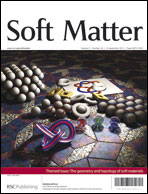Harnessing instabilities for design of soft reconfigurable auxetic/chiral materials†
Abstract
Most materials have a unique form optimized for a specific property and function. However, the ability to reconfigure material structures depending on stimuli opens exciting opportunities. Although mechanical instabilities have been traditionally viewed as a failure mode, here we exploit them to design a class of 2D soft materials whose architecture can be dramatically changed in response to an external stimulus. By considering geometric constraints on the tessellations of the 2D Euclidean plane, we have identified four possible periodic distributions of uniform circular holes where mechanical instability can be exploited to reversibly switch between expanded (i.e. with circular holes) and compact (i.e. with elongated, almost closed elliptical holes) periodic configurations. Interestingly, in all these structures buckling is found to induce large negative values of incremental Poisson's ratio and in two of them also the formation of chiral patterns. Using a combination of finite element simulations and experiments at the centimeter scale we demonstrate a proof-of-concept of the proposed materials. Since the proposed mechanism for reconfigurable materials is induced by elastic instability, it is reversible, repeatable and scale-independent.

- This article is part of the themed collection: The geometry and topology of soft materials

 Please wait while we load your content...
Please wait while we load your content...